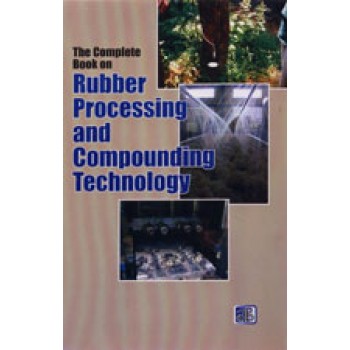The Complete Book on Rubber Processing and Compounding Technology
| Price: | Rs.1,575.00 |
Detail Of The Complete Book on Rubber Processing and Compounding Technology
| ISBN | 9788178330051 |
| Pages | 712 |
| Language: | English |
| Product Code: | 1 |
| Size(in cm): | 21*13.5 cm |
| Weight(in grams): | 500(approx) |
Description:
Rubber products industry is an important resource based industry sector in India. Over the last decade the rubber industry has witnessed a steady and strong growth. Rubber can be deformed to a high degree of strain in a reversible manner and this special property finds use in fields as diverse as transportation, material handling, health care, and sport and leisure activities. The technology of rubber began with the natural product known as natural rubber. The establishment of the structure of natural rubber led to sustained efforts for the development of synthetic rubbers using diene monomers, such as butadiene, isoprene and chloroprene. There are various kinds of rubbers; hydrogenated rubber, cyclised rubber, chlorinated rubber, nitrile rubber, synthetic rubbers, etc. Manufacturing of tire and other rubber products involves vulcanization process, an irreversible reaction between elastomers, sulphur and other chemicals. Vulcanization is the process that takes the native rubber of the rubber tree plant and removes sulfur while heating it. This strengthens the material, allowing it to withstand higher temperatures and stay flexible in the cold. There are special applications of rubber are in the areas of adhesives, coated fabrics including packaging and luggage items and rainwear, footwear, pipes and tubings, wire insulation, cables and sheaths, tank lining for chemicals and oil storage rubber mats, rubber, sports goods, toys balloons and miscellaneous products. Rubber processing constitutes three components mixing, shaping and curing. Rubbers are difficult material to process, because in both raw and compounded state they have both viscous and elastic properties. Mixing is the most critical component of mixing processing. Mixing is usually carried out in a series of batches in a high speed internal mixer, in combination with a dump mill which cools and shapes the product for next process. India today is looked upon as world largest producer and third largest consumer of natural rubber. Global Rubber consumption is forecasted to rise up to 4.3% annually. A majority of rubber demand is accounted for by the motor vehicle sector, particularly via usage in tyres.
Some of the fundamentals of the book are rubbers: materials and processing technology, rubbers from stereo regular polymerization of isoprene and butadiene, rubbers from stereo regular polymerization of isoprene and butadiene, mixing technology of rubber, rubber vulcanization, rubber compounding, manufacture of rubber products, silicone rubber, styrene butadiene rubber (SBR), nitrile and polyacrylic rubber, grinding and pulverization technology, recycling of rubbers, rubber/recycled rubber blends, concrete modified by recycled rubber, etc.
The book covers manufacturing processes of rubber products, compounding of rubber, quality assurance, applications etc. Thus book is very resourceful for new entrepreneurs, existing units, technical institutions, technocrats etc.
Reviews (0)
Write a review
Your Name:Your Review:
Note: HTML is not translated!
Rating: Bad Good
Enter the code in the box below:



 |
| 